
Wolf spiders are members of the family Lycosidae. They are robust and agile hunters with excellent eyesight. They live mostly in solitude, hunt alone, and usually do not spin webs. Some are opportunistic hunters, pouncing upon prey as they find it or chasing it over short distances; others wait for passing prey in or near the mouth of a burrow.

Nursery web spiders (Pisauridae) is a family of araneomorph spiders first described by Eugène Simon in 1890. They resemble wolf spiders (Lycosidae) except for several key differences. Wolf spiders have two very prominent eyes in addition to the other six, while a nursery web spider's eyes are all about the same size. Additionally, female nursery web spiders carry their egg sacs with their jaws and pedipalps instead of attaching them to their spinnerets as wolf spiders do. When the eggs are about to hatch, a female spider builds a nursery "tent", places her egg sac inside, and stands guard outside, hence the family's common name. Like the wolf spiders, however, the nursery web spiders are roaming hunters that don't use webs for catching prey.
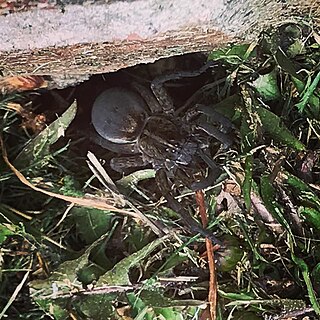
Tigrosa aspersa is a large wolf spider that inhabits the eastern United States. Compared to its close relative Tigrosa helluo, T. aspersa is much larger. This species was known as Hogna aspersa prior to 2012, when it was moved to Tigrosa.

Zoropsidae, also known as false wolf spiders for their physical similarity to wolf spiders, is a family of cribellate araneomorph spiders first described by Philipp Bertkau in 1882. They can be distinguished from wolf spiders by their two rows of eyes that are more equal in size than those of Lycosidae.
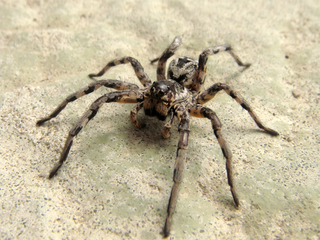
Lycosa tarantula is the species originally known as the tarantula, a name that nowadays in English commonly refers to spiders in another family entirely, the Theraphosidae. It now may be better called the tarantula wolf spider, being in the wolf spider family, the Lycosidae. L. tarantula is a large species found in southern Europe, especially in the Apulia region of Italy and near the city of Taranto, from which it gets its name.

The Artoriinae are a subfamily of wolf spiders. The monophyly of the subfamily has been confirmed in a molecular phylogenetic study, although the relationships among the subfamilies was shown to be less certain.
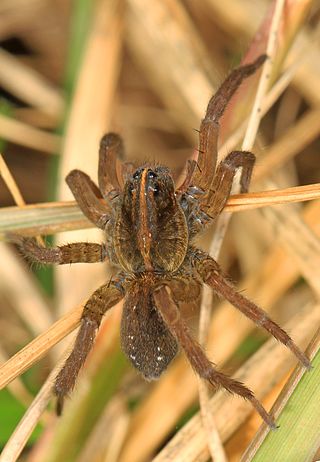
Tigrosa helluo is a species of spider belonging to the family Lycosidae, also known as wolf spiders. T. helluo was formerly known as Hogna helluo before differences between dorsal color patterns, habitat preferences, body structures, etc. were discovered. The species is native to the United States, Canada, and Mexico. It can be found across the eastern half of the United States, primarily in the Northeast and New England, and as far west as Nebraska and Kansas. T. helluo can be found in diverse habitats including woods, marshes, fields, and riparian areas. Typically, members of this species prefer to live in wetter areas as opposed to dry environments. Males tend to live for around a year and females will live for close to two years.

Tigrosa is a genus of spiders in the family Lycosidae, found in North America.
Melecosa is a genus of spiders in the family Lycosidae. Its lone species is found in Kazakhstan, Kyrgyzstan, and China.
Gulocosa is a genus of spiders in the family Lycosidae. It was first described in 2015 by Marusik, Omelko & Koponen. As of 2017, it contains only one species, the Russian species Gulocosa eskovi.

Tigrosa annexa is a species of wolf spider (Lycosidae) native to eastern North America from Texas, east to Florida, and north to Ohio.
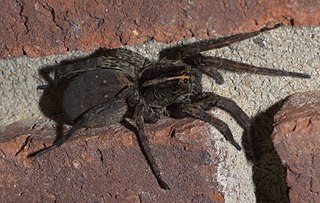
Tigrosa grandis is a species of wolf spider (Lycosidae) endemic to the United States, where it occurs from Montana, east to Missouri, and south to Texas.
Pardosa ramulosa is a species of wolf spider in the family Lycosidae. It is found in the United States and Mexico. The spider feeds primarily on prey near salt marsh habitat, and requires a varied diet.
Pirata aspirans is a species of wolf spider in the family Lycosidae. It is found in the United States and Canada.
Varacosa shenandoa is a species of wolf spider in the family Lycosidae. It is found in the United States and Canada.
Geolycosa wrighti is a species of wolf spider in the family Lycosidae. It is found in the United States and Canada.
Geolycosa xera, or Mccrone's burrowing wolf spider, is a species of wolf spider (Lycosidae) endemic to Florida in the United States.
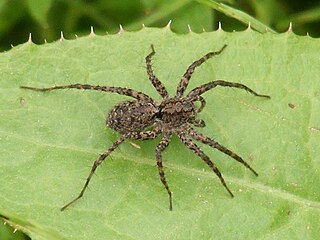
Pardosa milvina, the shore spider, is a species in the wolf spider family. They are mainly found near rivers and in agricultural areas in eastern North America. P. milvina feed on a large variety of small insects and spiders. Ground beetles such as Scarites quadriceps and large wolf spiders such as Tigrosa helluo are predators of P. milvina. P. milvina are smaller spiders with thin, long legs. This species captures prey such as arthropods with their legs and then kills them with their venom. Their predators are larger wolf spiders and beetles. P. milvina are able to detect these predators from chemotactile and vibratory cues. These spiders lose limbs when escaping from predators and they can change their preferred location in order to avoid predators. P. milvina also use chemical cues in order to mate. During their mating ritual, the male raises his legs and shakes his body. Both males and females can use silk, a chemotactile cue, for sexual communication. Additionally, female shore spiders heavily invest in their offspring, keeping them in egg sacs and carrying them for a few weeks after they are born.

Venator is a genus of Australian wolf spiders first described by Henry Roughton Hogg in 1900. As of April 2019 it contains only three species.
Halocosa is a genus of wolf spiders first described by G. N. Azarkina and L. A. Trilikauskas in 2019. As of December 2021 it contains only three species: H. cereipes, H. hatanensis, and H. jartica. The type species, Halocosa cereipes, was originally described under the name "Lycosa cereipes".











